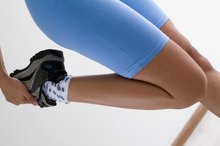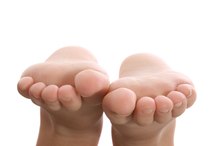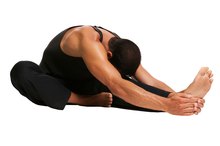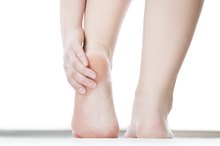Shin Stretches for Runners
Shin pain is a common complaint among runners. Athletes just starting a running program in particular risk developing pain if they do not adequately prepare for the impact on the shins. Even though they are a major component of the runner’s stride, shin muscles are not often targeted during conditioning, making them more prone to weakness. Strengthening and stretching the shin muscles will help to improve your running program and avoid injury.
Standing Shin Stretch
Because you perform this stretch standing and while wearing running shoes, the standing shin stretch is a useful preparation and follow-up to your run. Hold onto a wall or railing for support. Shift your weight to your left leg and bring your right foot back. Point your right foot toward the ground and place the tops of your toes on the ground. Slide your right foot forward until you feel a stretch in the front of your shin. Hold the position for 20 to 30 seconds and repeat three times. Switch legs and stretch your left shin.
- Because you perform this stretch standing and while wearing running shoes, the standing shin stretch is a useful preparation and follow-up to your run.
- Slide your right foot forward until you feel a stretch in the front of your shin.
Cross-Over Shin Stretch
How to Increase Flexibility in My Big Toes
Learn More
As with the standing shin stretch, the cross-over stretch is well-suited for pre- and post-running stretching. You can perform this stretch with or without shoes. Start standing with your feet together. Cross your right leg in front of your left leg and place the tops of your pointed right toes on the ground. Bend both legs until you feel a stretch in the top of your right foot and shin. Repeat three times on each foot and hold each stretch for 20 to 30 seconds.
- As with the standing shin stretch, the cross-over stretch is well-suited for pre- and post-running stretching.
- Bend both legs until you feel a stretch in the top of your right foot and shin.
Kneeling Shin Stretch
The ideal stretch to perform at home is the kneeling stretch. It stretches your shins while strengthening calves. Kneel on a carpeted area, folded blanket or yoga mat. Point your toes, contracting your calf muscles and stretching your shins. Hold the stretch for 20 to 30 seconds. Repeat two more times.
- The ideal stretch to perform at home is the kneeling stretch.
- Point your toes, contracting your calf muscles and stretching your shins.
Manual Shin Stretch
Stretching Exercises for ACL Injuries
Learn More
Stretch your shin manually while sitting in a chair. Cross your right ankle over your left thigh. Remove your shoe. Place your right hand on the back of your right calf to act as a leverage point. Rest the top of your right foot against your left forearm and place your left hand on the top of your ankle or shin. Press down with your left arm until you feel a stretch in your shin and top ankle. Hold for 20 to 30 seconds, repeating three times on each foot.
- Stretch your shin manually while sitting in a chair.
- Place your right hand on the back of your right calf to act as a leverage point.
Related Articles
References
Writer Bio
Kristin Shea has been writing professionally since 2008. Her fitness works include a yoga manual and Skincare News. She has acquired extensive legal writing experience during more than 10 years of legal practice. Shea is a licensed attorney and certified yoga instructor. She earned a Bachelor of Arts from University of Florida and a Juris Doctor from University of Miami Law School.








